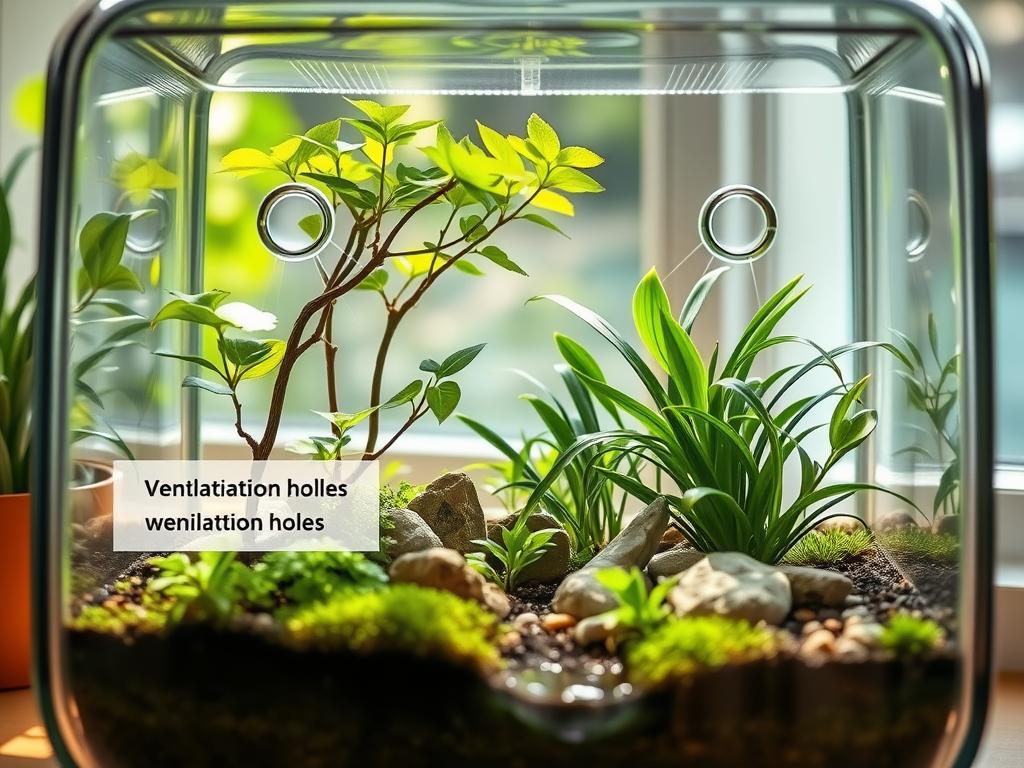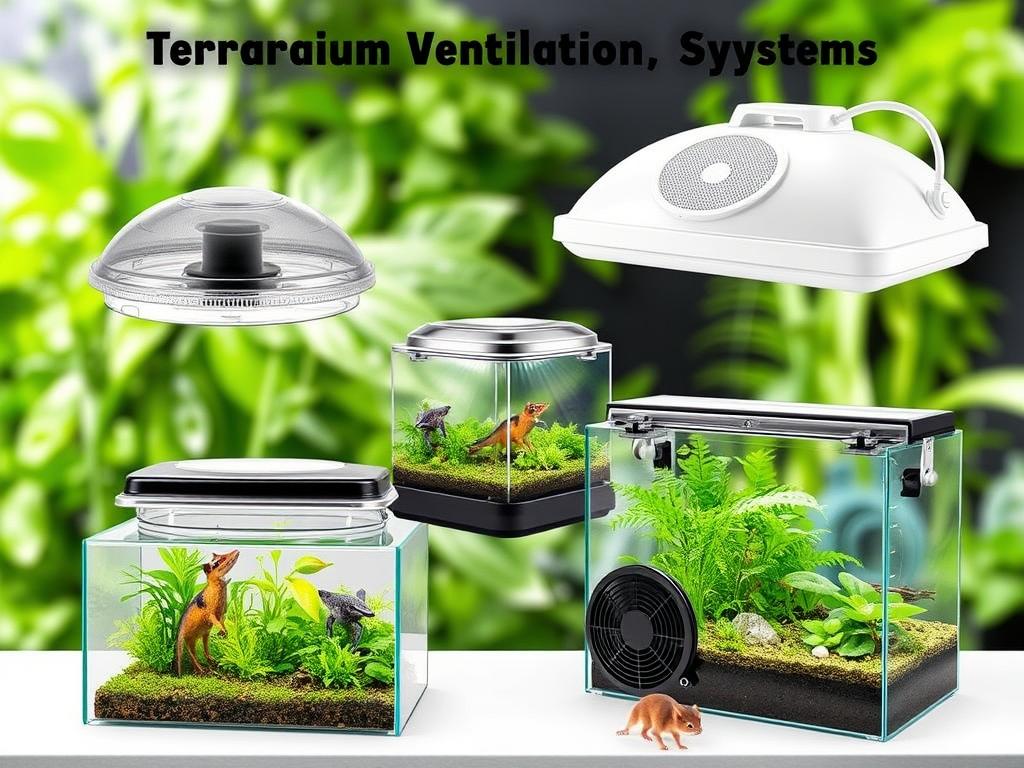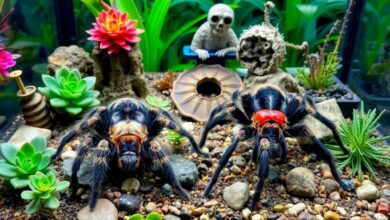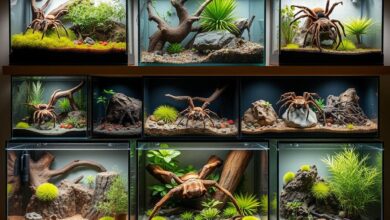How to ensure proper ventilation in the terrarium to prevent disease and stress

Proper ventilation is key for a healthy terrarium. Without enough air flow, you might see mold, humidity problems, and stress in your pets and plants. This guide will show you how to keep your terrarium well-ventilated. This way, you can stop diseases and make sure your reptiles, amphibians, and plants are happy and healthy.
Importance of Proper Ventilation in Terrariums
Keeping a terrarium healthy is key for animals like reptiles, amphibians, and invertebrates. Proper ventilation is essential for this. It helps control humidity and stops mold from growing.
Maintaining Optimal Humidity Levels
Right humidity is vital for your terrarium friends. Proper ventilation keeps air moving, stopping it from getting stuck. This keeps moisture levels right, which snakes and frogs need.
Preventing Mold and Fungal Growth
Good snake tank humidity regulation stops mold and fungus. Stagnant air lets these bad guys grow, harming your pets. Ventilation cuts down on mold and fungus risks, keeping your terrarium safe.
| Ventilation Requirement | Optimal Range |
|---|---|
| Temperature | 20-30°C |
| Humidity | 40-60% |
| Air Flow | 3-5 air changes per hour |
Proper ventilation is key for a healthy terrarium. It keeps humidity right and stops mold. This keeps your pets happy and healthy for a long time.

Types of Ventilation Systems for Terrariums
Keeping your terrarium well-ventilated is key for the health of your plants and animals. You have many options for ventilation systems, each with its own benefits. Knowing about the different types of terrarium ventilation systems helps you pick the best one for your terrarium and its inhabitants.
Active Ventilation Systems
Active systems use fans or pumps to move air in and out of the terrarium. They ensure a steady flow of fresh air and remove stale air. Active ventilation is great for big terrariums or those with species needing lots of air movement, like many reptile tank air circulation and amphibian enclosure air exchange setups.
Passive Ventilation Systems
Passive systems don’t use fans or pumps but rely on natural air flow. They use screen vents for terrariums or openings for air to move around. These systems are low on energy and easy to maintain, making them a top pick for smaller or less active terrarium ventilation systems.
Choosing the right ventilation system is crucial. Make sure it fits your terrarium’s size and the air needs of your active vs passive ventilation setup.

| Ventilation System | Key Benefits | Considerations |
|---|---|---|
| Active Ventilation |
|
|
| Passive Ventilation |
|
|
Proper ventilation of terrariums
Proper ventilation in terrariums is key for the health of the animals inside. Cross-ventilation and screen vents are two great ways to keep air moving.
Cross-Ventilation for Airflow
Cross-ventilation means air comes in and goes out on opposite sides. This creates a steady flow that stops air from getting stuck. It brings in fresh air, keeps the temperature right, and keeps humidity at the right level.
By placing intake and exhaust openings on opposite sides, you get a natural flow. This boosts air circulation in the terrarium.
Screen Vents for Air Exchange
Screen vents help with air exchange in terrariums. They let air move around, keeping humidity and temperature just right for reptiles, amphibians, and other pets. Putting vents on the top and sides helps balance airflow.
This stops air from getting stale and keeps animals healthy. Using cross-ventilation and screen vents makes terrariums better for your pets.
These methods help with cross-ventilation in terrariums, terrarium screen vent placement, reptile habitat air circulation, frog enclosure airflow, and snake tank ventilation.
Considerations for Different Terrarium Environments
The need for ventilation in a terrarium changes with the environment it mimics. Tropical terrariums need more ventilation to keep humidity levels right and prevent mold. Desert terrariums, on the other hand, need less humidity and different ventilation to avoid dryness.
Tropical Terrarium Ventilation Needs
Tropical terrariums aim to mimic the warm, humid conditions of rainforests and jungles. They house a variety of plants and animals that love these conditions. Tropical terrarium ventilation is key to keep the air fresh and prevent mold and fungi.
Desert Terrarium Ventilation Requirements
Desert terrariums have different needs for air flow. They must keep humidity low to match the conditions of deserts and dry regions. Too much moisture can harm the animals, so good ventilation is crucial.
It’s important to control humidity and temperature in terrariums, no matter the environment. This ensures the well-being of reptiles, amphibians, and snakes. It also keeps the terrarium healthy.
Monitoring and Adjusting Terrarium Ventilation
Keeping a terrarium well-ventilated means checking on it often and making changes as needed. You should watch the humidity, temperature, and air flow. This helps keep the right environment for your plants and animals.
It’s important to adjust the airflow in terrariums regularly. This keeps the reptile, amphibian, and snake habitats healthy. By checking and tweaking the setup, you avoid mold, bad air, and wrong temperature and humidity levels. These can stress out your pets.
- Use a digital hygrometer and thermometer to check humidity and temperature.
- Open the lid or door to see how well the air moves.
- Change the ventilation to keep the conditions perfect.
- Watch your pets for signs of stress or health problems that might mean bad ventilation.
- Keep track of what you see and do to improve the terrarium over time.
By keeping an eye on and adjusting the terrarium’s air flow, your pets will do great in their home.
Bioactive Terrarium Drainage and Ventilation
Creating a thriving bioactive terrarium needs good drainage and ventilation. These elements keep the balance right in a reptile habitat natural ecosystem or amphibian enclosure self-sustaining environment.
Benefits of Proper Drainage
Good drainage stops waterlogging in a bioactive terrarium. It keeps moisture levels right. This is key for your plants and animals’ health, as too much moisture can cause mold and fungus. A well-thought-out drainage system helps manage water well, preventing it from staying still.
Incorporating Ventilation into Bioactive Setup
Adding ventilation in bioactive setups is just as crucial as drainage. It keeps humidity levels in check, stopping air from getting stale. With vents or active systems, your bioactive terrarium drainage will mimic nature, giving your pets and plants what they need.
By focusing on both drainage and ventilation in your bioactive terrarium, you make a self-sustaining ecosystem. This approach to bioactive terrarium design keeps your reptiles, amphibians, or other pets healthy. It lets your reptile habitat natural ecosystem or amphibian enclosure self-sustaining flourish.
Signs of Poor Ventilation in Terrariums
Keeping your terrarium well-ventilated is key for your animals and plants’ health. If your terrarium’s ventilation is off, you’ll see signs that need quick action. Knowing these signs helps you fix ventilation issues before they get worse.
Condensation and Mold Growth
Excessive condensation on your terrarium’s walls is a clear sign of poor ventilation. This moisture makes mold and fungi grow, harming your animals and plants. If you see condensation and mold, your terrarium’s air flow is bad and needs fixing.
Plant and Animal Health Issues
Poor air flow in your terrarium can cause health problems for its creatures. Reptiles, amphibians, and snakes might eat less, move less, or have breathing issues. Plants could turn yellow, grow slow, or get fungal infections. Seeing these signs means your terrarium’s air flow is off and needs work.
By watching for these signs, you can fix ventilation issues early. This keeps your terrarium healthy for your animals and plants. Fixing ventilation problems quickly stops more issues and keeps your terrarium thriving.
| Product | Size (gallons) | Ventilation Features | Price |
|---|---|---|---|
| Repti Zoo Glass Reptile Terrarium | 65 | Sliding doors and mesh screens | $199.99 |
| New Age Pet ECOFLEX Mojave Reptile Lounge | 120 | Mesh lids | $249.99 |
| Repti Zoo Large Glass Reptile Terrarium | 120 | Mesh lid | $319.99 |
| Repti Zoo Double Hinge Glass Reptile Terrarium | 50 | Mesh panels | $159.99 |
| OiiBO Glass Screen Ventilation Reptile Terrarium | 65 | Sliding doors and mesh panels | $199.99 |
Reptile Habitat Humidity Control
Keeping the right reptile habitat humidity is key for your reptile’s health. Too little humidity can cause breathing problems, skin issues, and other health issues. Proper terrarium ventilation helps control humidity. This keeps the environment right for your reptile.
It’s important to check and adjust the humidity levels often. Here are some tips for managing terrarium humidity:
- Get a good humidity monitor to keep an eye on moisture levels.
- Use ventilation systems like fans or vents for air flow and the right humidity range.
- Choose the right substrate and decor to help control amphibian enclosure moisture.
- Give the enclosure a mist or a light spray to add snake tank humidity when needed.
- Keep an eye on the bioactive terrarium humidity and adjust as needed to keep conditions perfect.
By managing the reptile habitat humidity well, you make a great home for your reptiles. Regular checks and tweaks will keep their environment just right for them.
Vivarium Ventilation Systems for Optimal Airflow
Proper ventilation is key for a healthy vivarium. You have two main options: active and passive ventilation. Knowing the differences helps you pick the best for your setup and its creatures.
Active Ventilation Systems
Active systems use fans or blowers for better air circulation. They let you control airflow and exchange rates for your vivarium’s needs. This is great for big vivariums or those with species needing lots of air movement.
Passive Ventilation Solutions
Passive systems use natural airflow. They have vents, openings, or convection currents. This is good for smaller vivariums or those designed well. It’s energy-efficient and doesn’t need extra equipment.
When deciding, think about your vivarium’s size, the animals inside, and your energy use and control needs. This will guide you to the best ventilation choice for your vivarium’s health and happiness.
Terrarium Air Circulation for Various Species
The air circulation in a terrarium changes a lot based on the plants and animals inside. Tropical species need more air to keep humidity right. Desert species prefer less air movement. It’s key to think about each species’ needs for a healthy terrarium.
For reptiles, good airflow is vital for temperature and humidity control. Snakes and lizards need the right air flow for their health. Amphibians like frogs and salamanders need a humid environment. So, their terrariums need special ventilation.
Knowing how important air circulation is for your terrarium helps you keep it thriving. By watching your terrarium and adjusting as needed, you can make a great home for your plants and animals.



